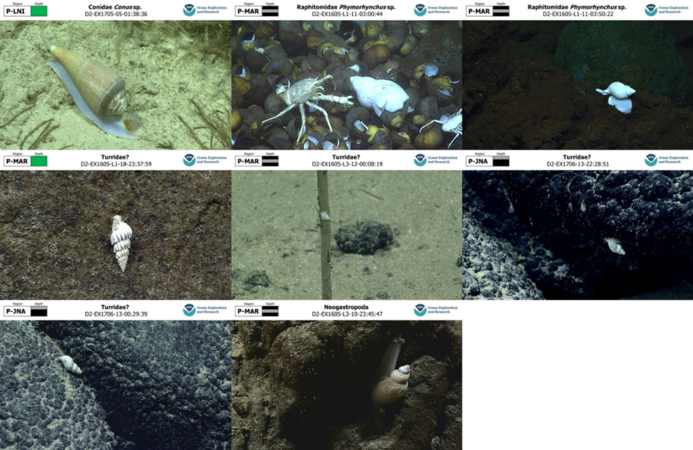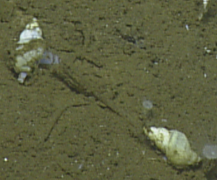De Atlas de Morfotipos de la Megafauna Abisal del Archipiélago Revillagigedo
| Línea 25: | Línea 25: | ||
<ref name="Sasaki"> Sasaki, T., Warén, A., Kano, Y., Okutani, T., & Fujikura, K. (2010). Gastropods from Recent Hot Vents and Cold Seeps: Systematics, Diversity and Life Strategies. In S. Kiel (Ed.), The Vent and Seep Biota (Topics in Geobiology, Vol. 33, pp. 169–254). Springer. https://doi.org/10.1007/978-90-481-9572-5_7 </ref> | <ref name="Sasaki"> Sasaki, T., Warén, A., Kano, Y., Okutani, T., & Fujikura, K. (2010). Gastropods from Recent Hot Vents and Cold Seeps: Systematics, Diversity and Life Strategies. In S. Kiel (Ed.), The Vent and Seep Biota (Topics in Geobiology, Vol. 33, pp. 169–254). Springer. https://doi.org/10.1007/978-90-481-9572-5_7 </ref> | ||
<ref name="Keen"> Keen, M. (1971). Sea Shells of Tropical West America. Stanford University Press </ref> | <ref name="Keen"> Keen, M. (1971). Sea Shells of Tropical West America. Stanford University Press </ref> | ||
| − | <ref name="Camacho"> Camacho, H | + | <ref name="Camacho"> Camacho, H., & del Rio, C. (2008). Gastropoda. In H. Camacho (Ed.), Los Invertebrados Fósiles (1st ed., pp. 323–376). Fundación de Historia Natural Félix de Azara. https://www.researchgate.net/publication/255970136_Gastropoda |
| + | </ref> | ||
<ref name="Brusca">Brusca, R., Moore, W., & Shuster, S. (2016). Invertebrates (3ra ed.). Sinauer Associates, Inc </ref> | <ref name="Brusca">Brusca, R., Moore, W., & Shuster, S. (2016). Invertebrates (3ra ed.). Sinauer Associates, Inc </ref> | ||
</references> | </references> | ||
Revisión actual del 12:33 26 ago 2022
Orden Neogastropoda
Los neogastrópodos son marinos y casi todos son de hábitos carnívoros o carroñeros. El grupo se compone de unas 16 000 especies vivas. Las familias que se encuentran usualmente en ventilas hidrotermales son Buccinidae y Turridae [1][2].
Se caracterizan por tener una concha generalmente grande, no nacarada, que suele ser espiralada o cónica y que presenta un canal sifonal prominente del que sobresale un sifón anterior (Fig. 1). Si presenta un opérculo este es quitinoso [3][4][5].
Figura 1. Miembros del orden Neogastropoda de mar profundo (obtenida de https://www.gbif.org/es/species/225)
Morfotipos identificados
Morfotipo 1
Referencias
- ↑ Cunha, R., Grande, C., & Zardoya, R. (2009). Neogastropod phylogenetic relationships based on entire mitochondrial genomes. BMC Evolutionary Biology, 9(1). https://doi.org/10.1186/1471-2148-9-210
- ↑ Sasaki, T., Warén, A., Kano, Y., Okutani, T., & Fujikura, K. (2010). Gastropods from Recent Hot Vents and Cold Seeps: Systematics, Diversity and Life Strategies. In S. Kiel (Ed.), The Vent and Seep Biota (Topics in Geobiology, Vol. 33, pp. 169–254). Springer. https://doi.org/10.1007/978-90-481-9572-5_7
- ↑ Keen, M. (1971). Sea Shells of Tropical West America. Stanford University Press
- ↑ Camacho, H., & del Rio, C. (2008). Gastropoda. In H. Camacho (Ed.), Los Invertebrados Fósiles (1st ed., pp. 323–376). Fundación de Historia Natural Félix de Azara. https://www.researchgate.net/publication/255970136_Gastropoda
- ↑ Brusca, R., Moore, W., & Shuster, S. (2016). Invertebrates (3ra ed.). Sinauer Associates, Inc

